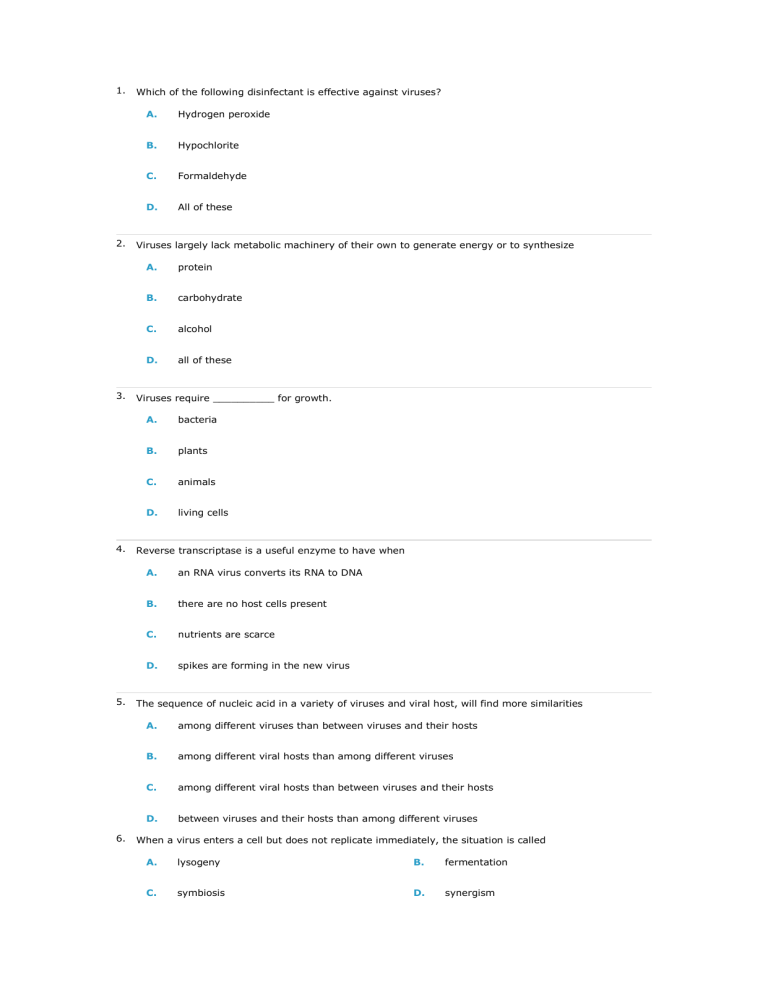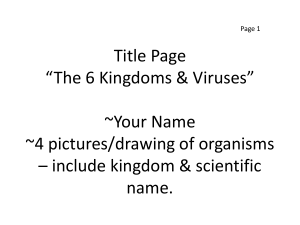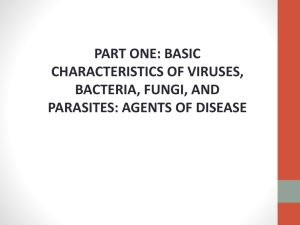qustions bank part II

1. Which of the following disinfectant is effective against viruses?
A.
Hydrogen peroxide
B.
Hypochlorite
C.
Formaldehyde
D.
All of these
2. Viruses largely lack metabolic machinery of their own to generate energy or to synthesize
A.
protein
B.
carbohydrate
C.
alcohol
D.
all of these
3. Viruses require __________ for growth.
A.
bacteria
B.
plants
C.
animals
D.
living cells
4. Reverse transcriptase is a useful enzyme to have when
A.
an RNA virus converts its RNA to DNA
B.
there are no host cells present
C.
nutrients are scarce
D.
spikes are forming in the new virus
5. The sequence of nucleic acid in a variety of viruses and viral host, will find more similarities
A.
among different viruses than between viruses and their hosts
B.
among different viral hosts than among different viruses
C.
among different viral hosts than between viruses and their hosts
D.
between viruses and their hosts than among different viruses
6. When a virus enters a cell but does not replicate immediately, the situation is called
A.
lysogeny B.
fermentation
C.
symbiosis D.
synergism
7. Usually viruses are separated into several large groups based primarily on
A.
nature of the host
B.
nucleic acid characteristics
C.
capsid symmetry
D.
diameter of the viroin or nucleocapsid
8. The first step in infection of a host bacterial cells by a phage is
A.
adsorption B.
absorption
C.
penetration D.
replication
9. Which of the following viruses has not been associated with human cancer?
A.
Hepatitis C virus
B.
Hepatitis B virus
C.
Varicella-Zoster virus
D.
Herpes simplex virus type 2
10. The viral nucleocapsid is the combination of
A.
genome and capsid
B.
capsid and spikes
C.
envelope and capsid
D.
capsomere and genome
11. Edward Jenner began inoculating humans with material from __________ lesions.
A.
Smallpox B.
Avianpox
C.
Cowpox D.
Chickenpox
12. The viruses in an attenuated vaccine
A.
have no genome
B.
continue to replicate
C.
are usually larger than bacteria
D.
is altered with chemicals
13. Enveloped viruses have a __________ shape.
A.
icosahedral
B.
helical
C.
roughly spherical
D.
complex
14. The envelope of which of the following viruses is derived from the host cell nucleus?
A.
Paramyxoviruses B.
Retroviruses
C.
Orthomyxoviruses D.
Herpesviruses
15. Which of the following is semi-continuous (diploid) cell line?
A.
HeLa B.
HEp-2
C.
WI-38
23. In order for a virus to replicate
A.
the capsid must enter the host cell cytoplasm
D.
KB
B.
the host cell must be undergoing mitosis
C.
the genome must be released in the cytoplasm
D.
the host cell must lack a cell membrane
28. Which of the following statements is not true of viruses?
A.
Viruses have been successfully grown in pure cultures in test tubes
B.
All viruses are obligatory intracellular parasites
C.
All viruses have either DNA or RNA as their genetic material
D.
Viruses probably arose from small fragments of cellular chromosomes
30. In the simplest capsid, there is a capsomere at each of the 12 vertices; this capsomere, which is surrounded by five other capsomeres, is termed a
A.
penton B.
polyhedra
C.
icosahedral
31. The size of viruses is usually measured in
A.
centimeters
D.
helical
B.
micrometers
C.
nanometers D.
millimeters
5. The bread mold Rhizopus stolonifer belongs to which of the following fungal divisions?
A.
Ascomycota B.
Deuteromycota
C.
Oomycota
6. Saprophytic fungi
A.
engulf their food in order to break it down.
D.
Zygomycota
B.
secure their food from dead organic materials
C.
both (a) and (b)
D.
none of the above
7. The fruiting body of a mushroom is called
A.
sorocarps
C.
ascocarps
B.
basidiocarps
D.
plasmodiocarps
10. __________ produce basidiospores.
A.
Slime molds
B.
Dimorphic fungi
C.
Club fungi
D.
Sac fungi
13. Which of the following does not represent a human disease caused by fungi?
A.
Ringworm
B.
Cryptococcosis
C.
Malaria
D.
Jock itch
18. __________ exhibit yeast-like growth at human body temperatures and mold-like growth at room temperature.
A.
Dimorphic fungi
B.
Black bread molds
C.
Sac fungi
D.
Water molds
20. Fungi
A.
are photosynthetic
B.
are prokaryotic cells
C.
have cell walls of peptidoglycan
D.
secrete extracellular enzymes to breakdown nutrients
22. Fungi in the division Deuteromycota are characterized by the fact that
A.
they only reproduce sexually
B.
they form sexual spores called deuterospores
C.
they are incapable of sexual reproduction
D.
a method of sexual reproduction has not been identified
25. __________ produce ascospores in an ascus.
A.
Slime molds
B.
Dimorphic fungi
C.
Club fungi
D.
Sac fungi
26. Ecologically fungi are important because
A.
B.
C.
D.
they act as decomposers and aid in nutrient cycling they are a major cause of plant diseases
Both (a) and (b) none of the above
27. The basidiomycetes include plant parasites that can cause
A.
rust and smut diseases
B.
candidiasis
C.
ergot disease
D.
Dutch elm disease & chestnut blight
30.
__________ produce zygospores.
A.
Slime molds
B.
Dimorphic fungi
C.
Club fungi
D.
Black bread molds
31. Which of the following is/are the sexual spore?
A.
Ascospores
B.
Basidiospores
C.
Both (a) and (b)
D.
None of these
32. Mushrooms are classified in which of the following division?
A.
Ascomycota B.
Basidiomycota
C.
Zygomycota
33. Name the asexual spore(s)?
A.
Conidia
D.
Deuteromycota
B.
Sporangiospore
C.
Arthospores
D.
All of these
37. Molds are considered as
A.
mesophillic
B.
psychotropic
C.
thermophillic
D.
all of these
39. Fungi are important in the production of all of the following commercial products except
A.
bread B.
beer
C.
cheese D.
rubber
40. Which of the following is not a member of the division Ascomycota?
A.
Aspergillus B.
Claviceps
C.
Penicillium D.
Rhizopus
41. Which of the following divisions of fungi produce uniflagellated zoospores?
A.
Ascomycota B.
Chytridiomycota
D.
Zygomycota C.
Oomycota
47. Fungi are generally not
A.
multicellular
B.
containing cell walls
C.
photosynthetic
D.
spore-producing
50. Which of the following structures would not be associated with fungi?
A.
Mitochondria
B.
Cell walls
C.
Chloroplasts
D.
Spores
52. An organism in the Deuteromycota has all the following except
A.
asexual spores
B.
absorptive nutrition
C.
ascospores, basidiospores or zygospores
D.
a nucleus
54. The terms mycelium and hyphae are associated with
A.
algae B.
fungi
C.
protozoa D.
viruses
56. Yeast play an important role in the alcohol industry, converting pyruvic acid into carbon dioxide and ethyl alcohol by the process of
A.
glycolysis
B.
respiration
C.
fermentation
D.
Krebs cycle
57. Ascospores located in asci are found in
A.
conidiocarps B.
sorocarps
C.
ascocarps
58. Enveloped viruses a) Are sensitive to outside conditions b) Produces diseases transmissible via direct contact c) Are viruses that have polysaccharide capsule d) Are less sensitive to outside conditions
D.
59. SARS is a) RNA virus – coronavirus b) DNA virus – coronavirus c) DNA vírus – pneumovirus d) RNA virus – rhinovirus plasmodiocarps
60. Hepatits C virus causes a) Not sever acute infection with good prognosis b) Chronical infection that can continue to cancerogenesis c) Latent disease with activation in the period of immunodificiency d) Infection that can start only if there is the co-infection with other hepatitis virus
61. Chronical infection of hepatitis B virus is characterised by : a) Presence of HBsAg for more than 6 months and disappearance of IgM anti HBc b) Presence of high levels of IgM anti HBc c) Absence of HbeAg d) Absence of IgG anti-HBc






